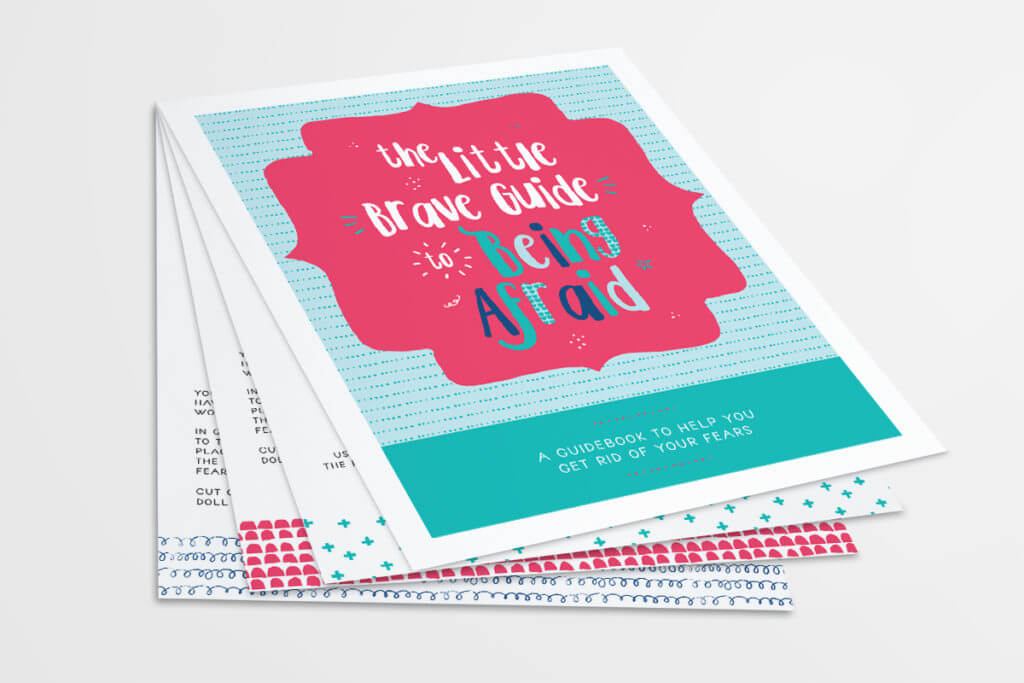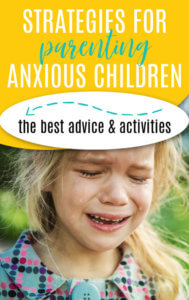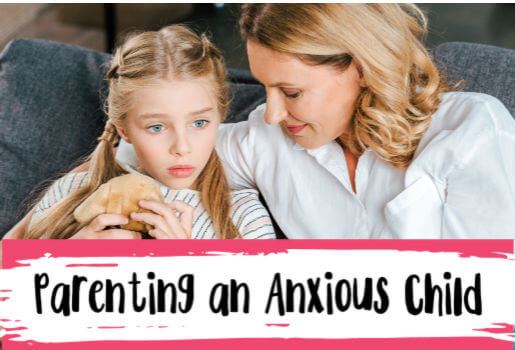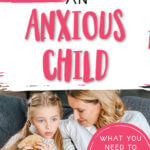If you are parenting an anxious child, chances are, you have tried a lot of ideas to calm your scared kid down.
You have also probably spent many hours feeling overwhelmed, unsure of how to help, and even frustrated with the seemingly uncontrollable nature of your child’s thoughts and actions. Parenting anxious children is not for the faint of heart!
The difference between Anxiety and an Anxious Personality
Anxiety is a mental health disorder. It is defined as an excessive and acute amount of worry over multiple activities and things for more days than not in a week for at least 6 months. If you feel like your child might fall into this diagnosis, I would highly recommend that you seek out a Mental Health Professional.
If your child has more of an anxious personality and tends to have low levels of anxious thinking, or goes through a week or two of feeling a lot of worry over one particular issue, then there are definitely things you can do to try to help your child at home.
Again, though, even if your child might not fall under the category of having an anxiety diagnosis, a counselor can be a great resource to help you in parenting an anxious child.
This post may contain affiliate links.
Parenting Anxious Children at Home
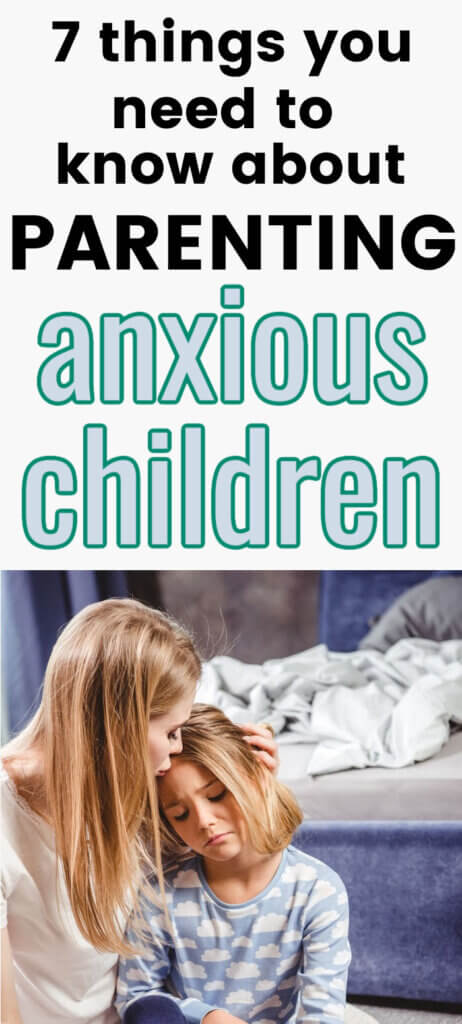
There are three main categories to think about when it comes to helping your anxious kid.
First, you want to uncover what is triggering your child’s worries. Triggers can come in all shapes and sizes. People, places, times of day, even diet can serve as a trigger for anxious thoughts.
Second, you will want to find a way to communicate with your child about their anxious thoughts and worries. Some kids will be able to talk to you directly but many kids don’t yet have the social and emotional skills to communicate on that level. Some kids will be able to communicate better through art, through play, through journaling, or any number of other ideas.
Finally, you will want to work on teaching your child skills to cope with their anxious thoughts and worries so that they are able to overcome feelings of fear or worry and function in their daily lives.
Understanding Your Child’s Fear Triggers
When it comes to parenting anxious children, one of the best ways to start to recognize and understand what is setting your child off into anxious thinking is to keep a log/journal for a week.
In your log/journal, note any situations that your child finds scary or seems to trigger anxious thinking. Keep an eye out for people that might heighten their anxiety as well.
Other things that you should pay attention to and notate include time of day and level of energy. (For example, many kids have a hard time with nighttime anxiety when they are feeling tired.)
You may also want to log foods as there has been some research pointing to certain foods like sugar and food dyes that can play havoc with children’s emotions and behaviors.
Talk to your child about what makes them start to feel scared
As you are working to figure out what is triggering your child, make sure to ask them. You may be surprised at simple things that you could easily fix or change to help make things less scary for them.
If Child is old enough, have them keep a log
Another option as you try to uncover fear triggers is to have your child keep their own log. This obviously will work better with older children.
Encourage your child to notate date, time, and what they are feeling anxious about. Have them try to think about what first made them start having this fearful thought and write that in with their other notations.
Finding an Outlet for Communicating Anxious Thoughts
Anxious thoughts tend to multiply and grow when kept inside. Kids often have very vibrant imaginations so when left alone with scary thoughts, monsters and fears will grow.
One way to address this is to find ways to bring the thoughts out of the head so that they can be dealt with. This article has a number of different interactive ideas for talking to kids about their fears.
Adults tend to have developed skills to talk about their feelings and name what they are thinking and afraid of. Kids don’t always have those skills. If your child isn’t naturally drawn to talking about their feelings, there are other ways to help them get their fears out of their heads.
Some other ideas for expressing anxious thoughts include drawing about them, writing poetry or creative stories, and using physical exercise or movement while stating fears. (Basketball or playing toss is a great way to engage a physically motivated kid – they state a thought each time they pass the ball.) Encouraging a child to play out their fears with toys is another option. (Legos, dolls, action figures, even stuffed animals all work great for this.)
Teaching Coping Skills
Once you and your child have more of a handle on what fears and worries they are struggling with, you will want to turn towards teaching them skills to overcome those anxious thoughts.
Coping skills are a great strategy when it comes to parenting anxious children. They offer a way to calm down fears. Kids are often very open and receptive to learning these skills and putting them into practice.
What Coping Skills Skills to Teach
There are many different types of coping skills you could teach your child. I use a lot of deep breathing, distraction techniques, and physical movement with my own children. You can read more about different coping skills and how to choose which ones to teach in this article here: How to Help Children Manage Fear
Practice Makes Perfect When It Comes to Coping Skills
The most important aspect of teaching children coping skills is practicing those skills so that they become ingrained. Try incorporating a quick coping skills practice into your bedtime routine or at the beginning of dinner for example.
You can also encourage your child to practice throughout the day by providing them with helpful tools such as deep breathing posters hung in their bedroom or having calm down cards in the car.
Modeling Coping Skills
Children will also be much more willing to practice and use coping skills when they see their parents using them. When you find yourself feeling anxious, angry, sad, or any other emotion, try verbalizing your feelings and model using a calm down skill in front of your child.
This helps your child learn that having big emotions is totally normal and that we all are able to control our reactions to our emotions if we choose to.
Using Coping Skills When Needed
The more your child practices and sees coping skills, the more they will start naturally using them in the moments that they need them. In the beginning make sure to encourage them to use those skills when you see them getting anxious.
If your child has worries around a routine event such as bedtime or going to school, be proactive, and use coping skills as a way to transition into those times.
Anxious Child Parenting
There are ways that you can help your anxious child address their worries and fears. Helping your child learn to communicate their fearful thoughts and use coping skills to overcome those worries will help them be able to overcome the fears and move through them.
If you feel like you have tried it all and it is still not helping, try reaching out to a professional for help. This article from ChildMindInstitute.com is a great resource for addressing anxiety in children from a mental health perspective.
Sometimes having a neutral third party can be very helpful and allow children to finally find ways to move past their fears.
The Brave Guide to Being Afraid
This workbook is also another good resource to help your child learn to identify their triggers and begin to learn to manage their fear and anxiety.
